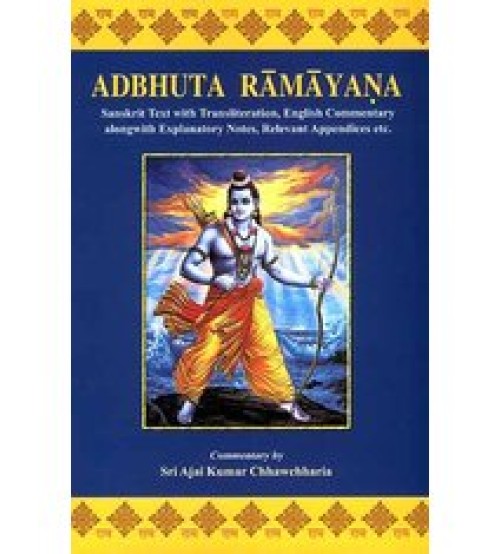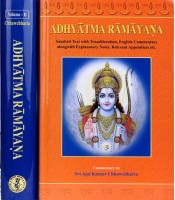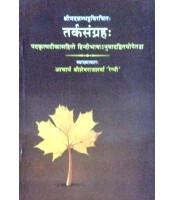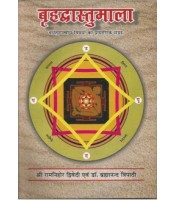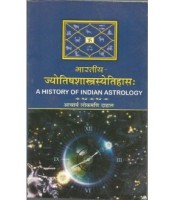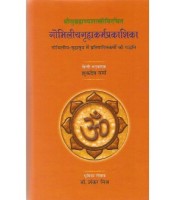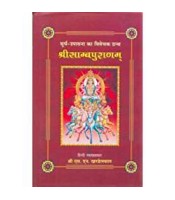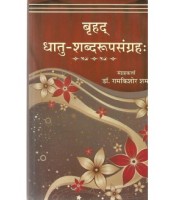Adbhuta Ramayana of Srimad Valmiki
Product Code: CSBS 7
Author: Sri Ajay Kumar Chhawchharia
ISBN: 9789380326047
Bound: Hard Cover
Publisher: Chaukhamba Surbharati Prakashan
Pages: 24+520
Language: sanskrit & english
Availability: 4
Adhbut Ramayan authored by sage Valmiki, who is famous for his classic epic ‘Ramayan’. Describes a highly strange, mysterious and fantastic version of the epic story of Lord Ram, the legendary king emperor of Ayoydhya and an incarnation of Lord Vishnu, the supreme Lord in creation. It reveals many hitherto little known events in the life of Lord Ram and his divine consort Sita which Valmiki knew but desisted from incorporating them in his earlier epic. He wrote this classic work ti fill that gap and put the record straight.
This classic book can be broadly divided into two parts. The first (canto 1-16) elaborately describes some mysterious and strange circumstances pertaining to the birth of Lord Ram and Sita; it also contains profound Vedanta philosophies when Sri Ram preaches Hanuman about them. the second part (canto 17-27) presents the story of Sri Ram’s campaign against the thousand headed demon king Ravana of Pushkar who was the elder brother of the ten headed Ravana of Lanka, and much stronger and powerful than latter. In this war, Sita assumed the form of mahakali, the dar-skinned Goddess worshipped as Shakti, to slay this Ravana and his demon force. The demon army has been described in great detail.
The climax of the book and the aspect which makes it so unique and holy is when lord Rama prays to the cosmic Goddess or Shakti uning 1008 divine names or mantras which describe and enumerate the various glories virtues and attributes of the magnificent Shakti of Mother Nature. This is the only classic Composition where the Shakti has been worshipped using there profound mantras. This volume describes the text in great detail, incorporating commentary explanatory & relevant notes when required. An elaborate life sketch of sage Valmiki incorporating numerous little known facts about him, have been included to give a special unique flavour to this book. Besides this, important metaphysical concepts appearing in the text have been explained in a separate appendix.
Ajai Kumar Chhawchharia born on 8th August, 1955 in Burdwan district of West Bengal, is a humble and unpretentious bachelor, who has dedicated his entire life to the service of Lord Ram. At present he is residing in the holy pilgrim city of Ayodhya (U.P. India) since 1985.
Preface
sitaya mulabhutayah prakrtescaritanca yat// (sarga 1, slo. 11)
Valmiki replied, inter alia, ‘Oh Brahmin! Listen carefully to the great and glorious story related to the worldly deeds done by the heir of the Kakutstha clan (i.e. Sri Rama) in which the stupendously glorious and fascinating deeds done by Sita, who was a gross manifestation of the subtle primary, eclectic, ethereal energy and sublime force of creation, which are robust, vigorous and effective and called Mother Nature or ‘Prakrti’, assumes a preeminent role’ (canto 1, verse no. 11).
‘Adbhuta Ramayana’, as the name suggests, describes the most strange, wonderful, mysterious and awe-inspiring fascinating story of Ramayana, the chronology of the fantastic worldly deeds done by Sri Rama and Sita, who were manifestations of Lord Visnu and his divine consort Goddess Laksmi respectively on the earth to get rid of evil forces personified by the demons, which was hitherto unknown in this world. It is a strange and mysterious story, quite different from the general perception about the story of Ramayana in which Sri Rama is the main hero and he occupies the central stage throughout the epic. This is the story where Sita, who was not only the manifestation of Goddess Laksmi and a divine consort of Sri Rama but also of the primary forces of and energy responsible for creation, collectively called ‘Prakrti’ (Nature) and ‘Maya’ (deluding powers of Nature), plays a prominent role. The story revolves around Sita more than it does around Sri Rama, and it seeks to establish the greatness, the valour and courage, the strength, powers and potentials, the glory and majesty of women and womanhood which are traditionally so much adored, admired, honoured and praised in India more than men and manhood. It is the ‘mother’ who really takes care of the world created by the father; it is Sita who provided succour and restored peace in the world when she finally killed the thousand headed Ravana of Puskara, who was the elder brother of the 10-headed Ravana of Lanka and equal number of times more powerful than his younger sibling, even though Sri Rama failed to subdue and vanquish him. It was Sita who finally overcame this great demon, restored peace on this earth by eliminating the scourage of all evil mongering demons representing vices and perversions on this earth. It was she who forcefully restored the balance in favour of righteousness and auspiciousness by eliminating all inimical forces that came in the way of righteousness and virtuousness.
The story of triumph and tragedy unfolds in 27 Cantos, and is an unconventional depiction of the epic story of Ramayana in various aspects. For one, it does not have the standard pattern of 7 ‘Kandas’ or Chapters of the conventional Ramayana (which are Bala Kanda, Ayodhya Kanda, Aranya Kanda, Kiskindha Kanda, Sundara Kanda, Lanka Kanda and Uttara Kanda). Rather, it is divided into 27 Cantos forming one homogenous text. Second, the reason why sage Narada cursed Visnu has been elaborately dealt with, as is the story of king Ambrisa who was one of the ancestors of Lord Rama (Canto 1-4). Third, Sita’s birth has been described in great detail and it establishes, most unconventionally again, that she was an immaculate conception of Mandodari, the wife of 10-headed Ravana. This particular episode of Sita’s strange birth gives a real mysterious twist to the generally held view about the birth and parentage of Sita, but a careful reading will dispel all doubts of any wrong doing or occurrence of any unrighteousness pertaining to her birth (canto 8). Earlier, the story describes why and how sage Narada had cursed Laksmi to force her to take birth as Sita and become the daughter of Mandodari, the wife of the 10-headed Ravana (canto 5-7).
Next we find that the author of the epic, sage Valmiki, has skipped all other events related to Sri Rama’s childhood, his going with sage Visvamitra to protect his fire sacrifice, and the marriage of Sri Rama and his brothers with Sita and her sisters at Janakapura. Our story of ‘Adbhuta Ramayana’ comes straight down to sage Parasurama coming angrily for a stand off with Sri Rama when the former learnt about the breaking of Lord Siva’s bow, called ‘Pinaka’, by Sri Rama, and which was a condition set by Sita’s worldly father Janaka for her marriage. He met the marriage party while it was on its way back to Ayodhya with the brides. Sri Rama confronted the sage boldly, vanquished his haughtiness and his sense of superiority as a vanquisher of the Ksatriya clan (verse nos. 10-16); Sri Rama then showed the sage his ‘Virat form’ which was the macrocosmic, all encompassing divine and colossus form of the supreme Lord of the cosmos (in verse nos. 17-20½). The sage’s ‘Teja’ (the divine energy, strength, powers and potentials which he possessed), which was given to him earlier by Lord Visnu, was snatched by the Lord, and the crest fallen sage was advised by him to go and do severe penances and austerities to recover them. All this is covered in canto no. 9.
Moving ahead with the fabulous story, we find that once again the narration jumbps straight to Sri Rama meeting Hanumana and showing his 4-armed vision of Visnu in canto 10. This, in conjunction with the Virat form shown to Parasurama in Canto 9, completes the depiction of Sri Rama’s true divine form as the supreme Lord of creation. Then the discourse between Sri Rama and Hanumana follows, which expounds on the philosophy postulated and propounded by Vedanta relating to the Atma/soul, Brahma, the elements called ‘Bhutas’, the creatures, their interrelationship with each other, the concept of ‘Moksa’ (liberation and deliverance, emancipation and salvation etc.) in canto nos. 11, 12 and 14 The concept of ‘Bhakti’ (devotion, faith, reverence, allegiance, submission and surrender to the supreme Lord by his devotee) is also elucidated in detail in canto no. 13. These four cantos (nos. 11-14) have a high element of spiritual quotient and contain almost all the principle tenets of the Upanisads presented in a succinct manner.
Realising the true form of Sri Rama as the supreme Lord personified and manifested as a human, Hanumana praises him and prays to him in canto 15.
The entire episode of Sri Rama crossing the ocean, defeating and slaying the 10-headed Ravana at Lanka and coming back to Ayodhya to be crowned king have been summed up in merely 20 verses of canto 16 to emphasise the point that the main thrust of this ‘Adbhuta Ramayana’ is not to repeat what is the already known story of Sri Rama, a story which highlights and glorifies Sri Rama’s victory over the king the Lanka, but to emphasise the point that something more formidable was still to be achieved by the divine couple. A greater, many times more powerful and invincible enemy in the form of the thousand headed Ravana of Puskara still existed, and unless he was vanquished, the real glory of the divine couple Sri Rama and Sita would not have reached its pinnacle.
So we move on to the second half of the story. The real fascinating story of Adbhuta Ramayana starts from canto 17 when Sita informs the royal court of Sri Rama, attended by great sages and seers who had assembled there to congratulate and honour Sri Rama for his victory over the Ravana of Lanka, about the existence of a superior enemy in the form of a thousand headed Ravana who ruled at Puskara, and who was the elder brother of 10-headed Ravana of Lanka. She tells the assembly how she had come to know about him. This inspired Sri Rama to launch an audacious campaign against this formidable enemy. Canto 18-22 describe the ferocious, no-holds-barred war between the two, Sri Rama and the thousand headed Ravana of Puskara, which ultimately lead to Sri Rama being defeated and gravely wounded and lying unconscious in the battlefield in canto 22, verse nos. 48-50.
Lorem ipsum dolor sit amet, consectetur adipiscing elit. Multoque hoc melius nos veriusque quam Stoici. Si enim ita est, vide ne facinus facias, cum mori suadeas. Sin aliud quid voles, postea. Negat esse eam, inquit, propter se expetendam.
Tags: Sri Ajay Kumar Chhawchharia Adbhuta Ramayana of Srimad Valmiki


